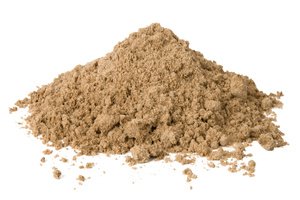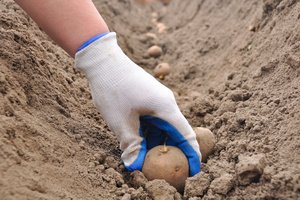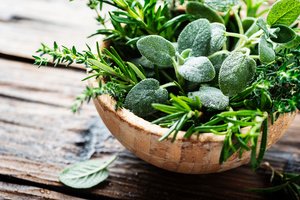If you live in an area with sandy topsoil, you might think that you are at a disadvantage when it comes to gardening and other yard projects. Although many people associate sand with barren deserts, sandy topsoil can be surprisingly useful. In addition to supporting a nice variety of vegetables and herbs, sandy soil can also be used in landscaping to provide visual appeal. Here is a closer look at what sandy topsoil is and what you can use it for.
Identifying Sandy Soil

Sandy soil is pretty easy to identify as it resembles the type of grainy sand that you find at the beach. If you take a handful of soil from your garden and try to squeeze it into a ball with your hands, it will simply run right through your fingers, while other types of topsoil may clump into balls that hold together fairly well.
Another telltale sign of sandy topsoil is the fact that when it rains, it will rarely make puddles. If you have attempted to plant anything in your soil and your plants constantly appear thirsty, there is a good chance that your soil has a high content of sand.
If you were to examine a jar of sand with a microscope, you would see what looks like a lot of marbles. That is because sandy soil consists of large, round particles that have a lot of spaces between them. It is precisely these spaces that cause rain and nutrients to wash right through the soil.
In fact, grains of sand are actually small bits of rocks, and as you can imagine, rocks are unable to hold water the way that softer pieces of humus or ground-up wood can. That does not mean, however, the sandy soil is undesirable. In fact, its loose and airy texture means that it promotes good drainage and does not become compacted.
In addition, it tends to freeze later in the winter and warms up faster when spring rolls around, which means you can enjoy a longer growing season. Moreover, the types of problems that can stem from over-watering in other types of soil, such as crown rot and root rot, do not occur in sandy soil.
With these unique properties in mind, here is a closer look at some of the top uses for sandy topsoil.
Growing Root Vegetables

The fact that water drains very quickly through sandy soil, bringing plant nutrients with it, makes it an unfriendly environment for growing many vegetables and fruits. However, root crops can grow quite well in the loose and crumbly texture of sand. Sandy soil is particularly suited to growing root vegetables such as potatoes, radishes, turnips and carrots. In fact, it can be difficult to grow carrots in any other type of soil. Although you may need to add some compost to your planting area, carrots tend to thrive when they are planted in sandy soil. When your carrot plants reach around 2 inches tall, just thin them out so that they are 2 inches apart as this will encourage the growth of long, straight roots.
Radishes are another good choice for sandy topsoil, and growing them can be very satisfying because they’re one of the fastest-growing vegetables. They can go from seed to harvest within as little as three weeks. They are also fun to grow because you can experiment with different varieties of radishes. If your sandy soil is free from rocks, you will enjoy radishes with a more even shape that lack indentations which are more visually appealing.
Growing Alliums
Alliums like onions and garlic grow very well in sandy soil. These are essential ingredients in a broad range of world cuisines, including Italian, Mexican and Asian. You will need to amend your soil using organic matter such as grass clippings or compost, but these root crops thrive in sandy soil.
Ornamental alliums also grow well in sandy soil. These flowering varieties can make a bold statement in your garden and are loved by pollinators. Many of them produce beautiful flowers, and because they are part of the garlic family, they tend to resist many common diseases and pests that can strike other types of flowers. The seeds can be spread liberally around the growing area and covered gently with around 1/4 inch of soil. They like lots of sun and a moderate amount of water.
Growing Herbs

Many herbs grow well in the slightly acidic conditions of sandy soil and appreciate its good drainage properties. For example, thyme fares well in sandy and rocky soils. This culinary herb hails from the Mediterranean region, which means it can tolerate drought and grows well in sandy soil. You’ll find more than 50 varieties of thyme, with some used for cooking and others that are grown as ornamental herbs. It also has some medicinal properties, helping to treat everything from inflammation and bronchitis to stomach pain. Thyme plants enjoy warm weather and full sun.
Another herb that grows well in sandy soil is rosemary. It can adapt well to nutrient-poor soils as well as dry conditions, which explains why it often thrives in sandy soil. It pairs well with savory dishes, especially poultry, along with soups and stews.
Oregano is a star in Italian cuisine and grows very well in sandy soil types as it appreciates dry, warm conditions and does not require a rich substrate. Although it is mostly used for cooking, it also has some medicinal value as well. The seeds can be planted after the last spring frost, and the plants prefer full sun. Oregano should only be watered when the soil feels dry to the touch.
Visual Appeal
Another use for sandy topsoil is to add visual interest to your landscapes. If you wish to give your yard a laid-back look or a coastal vibe, landscaping with sand can be very effective, and you’d be surprised by all the creative ways you can use it to lighten up the look and tone of your yard. You can use it to surround rocks and pebbles; create a desert-inspired space with aloe vera, cacti and succulents; or add a sandy play area to your landscaping. A meandering sandy path also looks nice in gardens.
Reach Out to Dirt Connections
Whether you are looking for sandy topsoil for a gardening project or you wish to amend topsoil that is too sandy so you can use it for other purposes, Dirt Connections can help. Call us today to discuss your project and arrange soil delivery in the Northern Virginia area.
Summary

Dirt Connections was started with one goal in mind: providing quality residential and commercial construction services to clients on time and on budget. Reach out for more information on how we can support your next project.
For your convenience our estimates are free and by appointment. Call 703-940-9949 for a free estimate today!










































